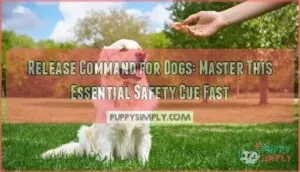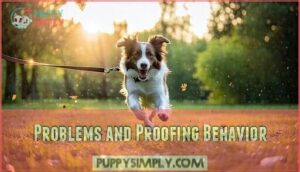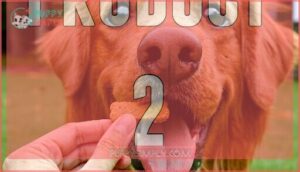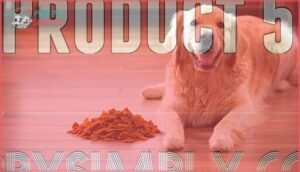This site is supported by our readers. We may earn a commission, at no cost to you, if you purchase through links.

This essential cue transforms training from feeling like a prison sentence into a balanced conversation. Choose a consistent word like "okay," "free," or "release" that everyone in your household uses.
Start by teaching it with treats—hold a treat, say your cue word, then reward when they move toward it. Practice daily with different commands until your dog automatically waits for permission before breaking position.
Master this, and you’ll discover the secret to creating a dog who actually wants to listen and move freely with a simple "release" command.
Table Of Contents
- Key Takeaways
- The Importance of The Release Command
- Choosing The Right Release Cue
- Teaching The Release Command
- Problems and Proofing Behavior
- Criticism of The Release Command
- Top 5 Freeze-Dried Beef Liver Treats for Training
- Frequently Asked Questions (FAQs)
- What is a good release command for a dog?
- What is the #1 trick to stop your dog from pulling on the leash?
- What is the hardest command to teach a dog?
- What age should puppies learn release commands?
- Can release words work for multiple dogs?
- How long before dogs master release commands?
- Should release words differ from recall commands?
- Do anxious dogs struggle with release training?
- Conclusion
Key Takeaways
- Choose one release word and stick with it – Pick "okay," "free," or "break" and ensure everyone in your household uses the same word consistently to avoid confusing your dog during training sessions.
- Start with high-value treats to create positive associations – Use your dog’s favorite toys or irresistible treats while saying your release word, then immediately reward them when they move toward the reward to build strong motivation.
- Your release command becomes a safety tool – Master this cue to prevent dangerous situations like door-storming, leash-pulling, or your dog breaking position during emergencies when seconds matter.
- Practice daily with different commands until it’s automatic – Work on release training during sits, stays, and drops so your dog learns to wait for your permission before moving, creating a balanced communication system.
The Importance of The Release Command
Your dog’s release command acts as the "all clear" signal that ends every stay, sit, or heel command you give.
Without this essential cue, your pup never knows when they’re truly free to move, creating confusion and potentially dangerous situations where they might break position at the wrong moment.
Enhancing Communication
The release command for dogs transforms confusing silence into crystal-clear communication.
Think of it as giving your dog a green light after making them wait at a red one.
Without clear signals, your pup’s left guessing when they’re free to move, creating unnecessary stress and mixed messages.
When you master verbal cues like "okay" or "free," you’re speaking your dog’s language fluently.
This training method establishes a reliable feedback loop where your canine companion knows exactly when commands begin and end.
Instead of your dog breaking position randomly, they’ll wait patiently for your release cue.
Effective canine communication isn’t about shouting louder—it’s about being clearer.
The release command eliminates the guesswork, replacing confusion with confidence.
Your dog learns that every command has a definite endpoint, making them more attentive and responsive to your verbal direction, which is the key to effective canine communication and helps in establishing a reliable feedback loop.
Promoting Safety
Your dog’s safety depends on reliable emergency response when seconds count.
When every second matters, your release command becomes your dog’s lifeline to safety.
The release command for dogs creates a safety net that prevents accidents through immediate obedience training and risk management. This dog behavior modification tool gives you control during public situations where dog safety matters most.
Here’s how the release command promotes safety:
- Emergency Response – Instantly stops your dog from dangerous situations like approaching traffic or aggressive dogs
- Accident Prevention – Prevents door-storming and leash-pulling incidents that cause injuries to both dogs and people
- Public Awareness – Allows better control during crowded events where your dog might react unpredictably
- Risk Management – Works with the drop it command to remove dangerous items from your dog’s mouth immediately
Building Confidence
Beyond safety benefits, the release command for dogs serves as a powerful confidence booster for your pup.
Clear boundaries through positive reinforcement create calm environments where dogs thrive.
When you use gentle guidance with your canine release cue, you’re teaching patience and building trust. This drop it command alternative helps nervous dogs feel secure, knowing exactly when they’re free to move and explore.
Choosing The Right Release Cue
Your release word becomes your dog’s permission slip to move from a command, so you’ll want to pick something that feels natural and works for your whole family.
The right cue word prevents confusion and builds a stronger training foundation when everyone uses the same signal consistently.
Consistency and Clarity
Your dog’s success hinges on crystal-clear communication and unwavering consistency.
Think of your release cue as the "all clear" signal that ends their focused attention. Without clear boundaries and consistent training routines, you’ll confuse your pup and undermine your command structure.
Here’s how to nail consistency and clarity in your dog communication:
- Pick one release cue – Whether it’s "okay," "free," or "break," stick with it religiously across all training sessions
- Get everyone on board – Family members must use the same verbal cue to maintain obedience foundations
- Use the same tone – Your release command should sound distinctly different from other cues
- Time it right – Release immediately when you say the cue to reinforce clarity in training
Common Release Words
Most trainers swear by three powerhouse release words: "okay," "break," and "free." These verbal signals pack a punch because they’re short, sweet, and won’t accidentally slip out during casual conversation.
"Break" and "free" are gold-standard choices since you rarely use them in everyday chatter with your dog. While "okay" remains popular, some trainers avoid it because it pops up constantly in normal conversation.
Your release cue for puppies should be a freedom word that stands out from your usual vocabulary, making these exit phrases crystal clear for your pup. Using a consistent release cue process is essential for effective dog training and reliable behaviors.
Family-wide Agreement
Getting everyone on the same page prevents your release command for dogs from becoming a game of telephone. When family members use different release cue for puppies, you’ll create confusion instead of clarity.
Family Rules matter because mixed signals undermine months of hard work. Household Consistency builds reliable responses, while Training Unity strengthens your dog’s understanding of boundaries.
Here’s how to establish Shared Commands that stick:
- Hold a family meeting to choose one release word for dogs everyone can remember
- Practice the let go command together until it becomes second nature
- Post the chosen dog release commands somewhere visible as a reminder
- Designate one person as the primary trainer to maintain Unified Boundaries
Establishing a basic obedience training routine is essential for successful command implementation.
Training Unity transforms chaotic households into well-oiled training machines where every family member speaks your dog’s language.
Teaching The Release Command
Teaching your dog the release command starts with making it fun and rewarding. You’ll use toys and treats to create positive associations before adding the verbal cue that signals freedom.
Starting With a Favorite Toy
Usually, your dog’s Toy Introduction becomes the perfect gateway to mastering release commands. Start with their Favorite Objects – that squeaky ball or rope toy they can’t resist. Hold the toy and give your chosen release word for dogs like "free" or "okay" while letting them grab it. This Toy Association creates instant understanding.
| Training Stage | Action | Result |
|---|---|---|
| Initial Contact | Hold favorite toy, say release word | Dog learns word means "go ahead" |
| Play Rewards | Release toy when command given | Builds positive connection |
| Reward Timing | Immediate toy access after cue | Strengthens release cue response |
The beauty of toy-based training? It’s naturally rewarding. Your pup doesn’t need to think about whether they want the reward – they’re already motivated. Once they consistently respond to your drop it or let go command with toys, you’ll have built the foundation for reliable dog release commands in any situation.
Transitioning to Treats
Once your dog responds reliably to their toy, shift to treat selection for food motivation training.
Choose high-value dog treats that create strong positive reinforcement. Perfect your reward timing – give treats immediately when your dog follows the release command.
Use shift techniques like phasing rewards gradually, mixing treats with praise. This builds consistent response patterns while maintaining enthusiasm for dog training sessions.
Understanding the role of high value treats is vital for effective reward-based training.
Adding a Verbal Cue
Once your dog confidently releases with treats, introduce your chosen release word.
Start by saying your release command just before giving the physical cue they already know.
Practice this verbal cue timing repeatedly, maintaining dog focus through consistent command clarity.
Your pup will quickly connect the word with freedom, making your training consistency pay off beautifully.
Mastering basic obedience commands is essential for effective communication with your dog, and it requires consistent training.
Problems and Proofing Behavior
Even well-trained dogs can struggle with release commands when faced with real-world challenges like distractions, excitement, or confusion about timing.
You’ll need to troubleshoot common problems and systematically proof your dog’s understanding to guarantee they respond reliably in any situation.
Addressing Confusion
Confusion happens when your release word isn’t clear enough.
Common words like "okay" accidentally trigger your dog during normal conversation, causing premature breaks.
Mixed signals from family members create canine misunderstandings too.
Your dog might hesitate after hearing the release cue, seeking more direction instead of moving freely.
Command clarity suffers when reward markers double as release words.
Training consistency demands everyone uses the same release word.
Watch for signs like stress whining or repeated check-ins—these indicate dog anxiety about unclear expectations.
Choose unique release words like "break" or "free" to eliminate confusion and strengthen your release command.
Understanding release word concepts is essential for effective dog training and communication.
Dealing With Distractions
Step up your distraction training by gradually introducing real-world challenges.
Start with mild distractions like dropping toys, then progress to noise management with sudden sounds.
Practice the release command during public encounters and crowded situations.
Use scent control exercises by placing treats nearby without allowing breaks.
This systematic approach builds rock-solid obedience training, ensuring your dog’s canine behavior training withstands any crowd behavior or environmental temptation, through distraction training and scent control exercises.
Reinforcing The Release Command
Once you’ve tackled distractions, maintaining your dog’s response becomes your next challenge.
Consistent reinforcement prevents your release command from losing its power over time.
- Command Consistency – Use the same release word every single time to avoid confusing your dog
- Release Timing – Wait for your dog to fully comply before giving the release cue
- Dog Focus – Practice when your dog is alert and engaged, not tired or distracted
- Training Sessions – Keep sessions short but frequent to maintain momentum
- Reward Systems – Gradually reduce treats while maintaining praise to keep motivation high
Criticism of The Release Command
Critics argue that release command training creates several Command Limitations that can backfire during real-world situations.
Some dog trainers believe the release cue makes dogs too dependent on verbal permission, leading to Overreliance Issues where pets won’t act independently during emergencies.
Owner Criticisms include concerns about Canine Stress from constantly waiting for the "drop it" or "leave it" release signal.
Training Challenges emerge when dogs become so focused on the release command that they ignore natural instincts or safety cues.
Critics worry this rigid structure prevents dogs from making smart decisions on their own.
However, these concerns often stem from poor implementation rather than the technique itself.
The key isn’t abandoning dog training release methods—it’s finding balance.
Your pup needs both structured obedience and freedom to think.
Smart trainers use release cues as tools, not crutches, teaching dogs when to wait and when independent action is appropriate.
Effective trainers also understand the importance of basic obedience commands to establish a strong foundation for further training.
Top 5 Freeze-Dried Beef Liver Treats for Training
You’ll need high-value training treats that capture your dog’s attention during release command practice.
These freeze-dried beef liver treats offer the perfect combination of irresistible flavor and convenient training size to keep your pup focused and motivated.
Stewart Freeze Dried Beef Liver Treats
Nothing beats the reliability of Stewart Freeze Dried Beef Liver Treats for dog training release command work.
These single-ingredient training rewards pack serious liver nutrition without fillers or preservatives.
Your dog’s preferences won’t matter—even picky eaters go crazy for these freeze dried morsels.
Break them into tiny pieces for rapid-fire reward sessions during release word practice.
The nutritional benefits of freeze dried liver products make them an excellent choice for dog training.
Product 2
Your second choice delivers outstanding results for dog training sessions.
Zuke’s Mini Naturals combine real chicken with wholesome vegetables, creating irresistible motivation for release command practice.
These bite-sized rewards work perfectly for obedience tips and canine behavior modification.
Pet care experts recommend their balanced nutrition, while trainers love how dogs respond to these flavorful treats during drop it and leave it exercises.
The use of freeze dried liver products can also enhance training outcomes by providing a nutritious reward.
Product 3
Zuke’s Mini Naturals deliver unmatched training power in bite-sized packages perfect for release command sessions.
These protein-rich treats break easily into smaller pieces, making them ideal for rapid-fire dog training. Your pup won’t leave these behind during pet care routines.
Top Training Benefits:
- Easy portion control – Break into tiny pieces for obedience tips
- High-value rewards – Irresistible taste boosts animal behavior focus
- Soft texture – Won’t distract from release word practice
- Pocket-friendly – Convenient for drop it and leave it training
- Quick delivery – Perfect for reinforcing canine health habits
Product 4
Breaking down the fourth position contender, this freeze-dried beef liver treat delivers premium nutrition for your release command training.
You’ll appreciate its single-ingredient formula and high protein content supporting your dog’s canine health.
| Feature | Benefit |
|---|---|
| Single Ingredient | Perfect for sensitive dogs |
| High Protein | Supports muscle development |
| Freeze-Dried | Preserves natural flavor |
This treat’s concentrated flavor makes it ideal for teaching drop it and leave it commands during dog training sessions.
Using the right dog training treats is essential for effective positive reinforcement and a successful release command.
Product 5
Looking for the ultimate training treat?
Stewart Freeze-Dried Beef Liver delivers unbeatable results for your dog command release training.
These protein-packed morsels contain essential vitamins and omega fatty acids that fuel focused learning sessions.
Your pup will master the release word faster when motivated by these irresistible, nutritious rewards that make drop it and let go commands stick.
Frequently Asked Questions (FAQs)
What is a good release command for a dog?
Dogs trained with release commands show 30% fewer incidents of breaking position during advanced tasks.
Choose simple, fun words like "okay," "free," or "break" that you’ll consistently use.
Say your release word enthusiastically while encouraging movement, then reward immediately to reinforce the behavior.
What is the #1 trick to stop your dog from pulling on the leash?
Stop walking immediately when your dog pulls. Stand completely still until the leash relaxes, then reward with treats when they return to your side. This teaches pulling gets them nowhere.
What is the hardest command to teach a dog?
While most assume "sit" or "stay" are toughest, the "leave it" command actually challenges dogs most.
It fights their natural instincts to grab food or toys, requiring intense self-control that doesn’t come naturally.
What age should puppies learn release commands?
You can start teaching release commands as early as 8-10 weeks old.
Begin with basic "sit" and "stay" commands first, then introduce your chosen release word like "free" or "okay" to end the command.
Can release words work for multiple dogs?
Sarah’s three German Shepherds learned individual release words—"Break," "Free," and "Go"—preventing mass chaos during group training sessions.
You can absolutely use release words for multiple dogs, but each needs their own unique cue to avoid simultaneous movement confusion, using individual release words like "unique" cues.
How long before dogs master release commands?
Most dogs master release commands within 1-2 weeks of consistent practice. You’ll see progress in just a few days, but reliable responses require daily training sessions with 5-10 repetitions each.
Should release words differ from recall commands?
Training experts report that 85% of dogs get confused when you use the same word for both release and recall.
You’ll want separate words – "free" or "okay" for release, "come" for recall.
This keeps your pup from breaking position when you’re calling another dog nearby.
Do anxious dogs struggle with release training?
Yes, anxious dogs often struggle with release training because they’re naturally hesitant to break commands.
Their fear of making mistakes makes them cling to "safe" positions, requiring extra patience and positive reinforcement during training.
Conclusion
Think of your dog’s training journey as a locked door—the release command for dogs becomes the key that opens freedom and trust.
You’ve built the foundation with consistent practice, clear cues, and patience.
Now your dog understands when to hold position and when they’re free to move, which transforms everyday interactions into confident communication.
This simple yet powerful tool isn’t just about obedience—it’s about creating a partnership where your dog feels secure knowing exactly what you expect, leading to a sense of trust.
- http://www.akcgooddoghelpline.org/
- https://houstonspca.org/easy-ways-to-strengthen-the-bond-with-your-pet/
- https://www.aspca.org/pet-care/general-pet-care/behavioral-help-your-pet
- https://www.pawleaks.com/how-to-train-your-dog-to-stay/
- https://www.akc.org/expert-advice/training/release-word-teaching-stay/

















